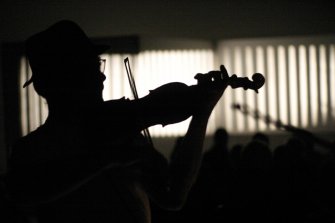Tony Conrad
Tony Conrad è una figura imprescindibile della neoavanguardia americana e delle scene artistiche di ricerca degli ultimi cinquanta anni. E’ stato uno degli iniziatori del minimalismo e un protagonista indiscusso della scena del cinema sperimentale di New York negli anni Sessanta. Realizza la colonna sonora del film culto di Jack Smith Flaming Creatures (1963), passando poi alla realizzazione di The Flicker (1966), capolavoro indiscusso che mette a confronto strutture armoniche musicali con i flash stroboscopici della luce. E’ stato co-fondatore del collettivo Theatre of Eternal Music (con John Cale, LaMonte Young e Angus MacLise) che ha sviluppato un linguaggio musicale del tutto inedito rispetto alle convenzioni del tempo e che si è definito Dream Music. E’ anche grazie a Conrad che è stato possibile svuotare certe convenzioni elitiste e autoritarie della musica colta innestando come condizioni l’improvvisazione, la partecipazione, la condivisione e un nuovo modo di ascolto completamente inedito attraverso l’utilizzo di intervalli armonici. Dopo la collaborazione con la formazione di krautrock Faust lungo gli anni Settanta, Conrad ha deciso di dedicarsi all’insegnamento alla Buffalo University, dove insegna tuttora. Negli anni ‘90 il suo lavoro è stato man mano riscoperto e, alla fine del decennio successivo definitivamente rimesso al centro anche come artista visivo a tutto campo, con episodi importanti come la partecipazione alla Biennale di Venezia nel 2009 con gli Yellow Movies o la pubblicazione di Beyond the Dream Syndicate: Tony Conrad and the arts after Cage (2008) di B. W. Joseph.
www.tonyconrad.net
Tony Conrad is an essential figure in the neo-avant-garde and American art research scenes of the last fifty years. He was one of the originators of Minimalism in music and is also an undisputed leader of the experimental film scene in the New York of the 1960s. He built his early reputation by creating the soundtrack to Jack Smith's masterpiece Flaming Creatures (1963), then moved directly on to making The Flicker (1966), an undisputed masterpiece that combines harmonic musical structures with the flash of the strobe light. He was the co-founder of the collective Theatre of Eternal Music (with John Cale, LaMonte Young and Angus MacLise) which developed a musical language that is unprecedented for the conventions of the time and that was defined as Dream Music. Thanks to Conrad again it was possible to remove certain elitist and authoritarian conventions of classical music by introducing improvisation, participation, sharing, and a new and completely novel way of listening through the use of harmonic intervals. Following the collaboration in forming Krautrock Faust in the seventies, Conrad decided to devote himself to teaching at Buffalo University, where he still teaches today. At the end of the twentieth century, his work was gradually rediscovered and, at the end of the next decade he was finally back at the centre as a full-blown visual artist, with important events such as participation at the Venice Biennale in 2009 with Yellow Movies or the publication of Beyond the Dream Syndicate: Tony Conrad and the arts after Cage (2008) by B. W. Joseph.

